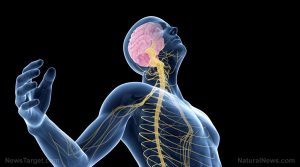
Neurofibromatosis – causes, side effects and treatments at NaturalPedia.com
Thursday, May 24, 2018 by Zoey Sky
http://www.naturalpedia.com/neurofibromatosis-causes-side-effects-and-treatments-at-naturalpedia-com.html

Neurofibromatosis is a genetic disorder of the nervous system. It can alter the development and growth of nerve cell tissues.
Neurofibromatosis causes tumors to grow on nerves, and it can also result in other abnormalities. The condition is made up of two different disorders:
- Neurofibromatosis type 1 (NF1) – Neurofibromatosis type 1 is a very common genetic condition, and it affects at least one in 3,000 to 5,000 individuals. It was first described in 1882 by Frederich von Recklinghausen, a German doctor. NF1 was previously called von Recklinghausen’s disease.
- Neurofibromatosis type 2 (NF2) – Neurofibromatosis type 2 is rarer than NF1. It only occurs in at least one in 33,000 to 40,000 births. A patient with NF2 develops tumors on nerves deep inside the body.

Known side effects of neurofibromatosis
The side effects of neurofibromatosis usually depend on the type, and it can spread throughout the whole body.
The side effects of NF1 may include:
- Coffee-colored marks – These usually appear at birth, but if more than six marks appear when a child turns five years old, this may indicate NF1. The marks can increase over time, and they may grow larger and darker.
- Freckles – These often appear in an unusual location, e.g., in the armpits, the groin, or under the breasts.
- Hypertension/high blood pressure – Patients with NF1 are more prone to hypertension.
- Lisch nodules – These are very small brown spots that can appear in the iris of the eye.
- Neurofibromas – Neurofibromas are tumors that are usually non-cancerous. These benign tumors may grow on the nerves of the skin or nerves deeper inside the body. They look like lumps under the skin.
The side effects of NF2 may include:
- Acoustic neuroma – A common type of brain tumor that develops on the nerve that connects the brain to the inner ear.
- Cataracts – Children who develop a cataract may have NF2.
- Facial numbness, weakness, and sometimes paralysis
- Gradual or (very rarely) sudden hearing loss
- Loss of balance, dizziness, and vertigo
- Tinnitus/ringing in the affected ear
- Spots of light brown pigmentation – These are rarer in NF2 cases, unlike in patients with NF1.
- Tumors – These usually develop on the brain, skin, and spinal cord. NF2 tumors may have severe consequences.
Body systems harmed by neurofibromatosis
Neurofibromatosis may cause different complications for NF1 and NF2.
The complications of NF1 may include:
- Benign skin tumors – Tumors can sometimes become cancerous.
- Early or late sexual development and puberty
- Epilepsy
- Gliomas/tumors on the eye nerves – These can occasionally cause eyesight problems.
- Hypertension
- Large head size
- Learning challenges – This may affect at least 50 percent of patients. Their coordination, short-term memory, and spatial awareness can also be affected.
- Scoliosis/curvature of the spine
- Short stature
- Skeletal problems
- Speech problems
- Vision and hearing problems – Often caused by a tumor/neuroma that presses on the nerves connected to the ears or eyes.
The complications of NF2 may include:
- Balance problems, convulsions, and eyesight problems – These can be caused by benign brain tumors that sometimes become cancerous. The tumors put pressure on parts of the brain.
- Benign skin tumors – These tumors may share the characteristic of NF1 tumors.
- Facial problems (e.g., difficulty blinking, smiling, or swallowing) – May occur due to tumors around the neck area.
- Numbness, pain in the limbs, and trembling – Often caused by spinal cord tumors that can develop on the nerves surrounding the spine.
Food items or nutrients that may prevent neurofibromatosis
The following foods or nutrients can help prevent neurofibromatosis and reverse the development of tumors:
- Aloe vera – The gel from aloe leaves is full of nutrients that can boost the immune system. Aloe also attacks abnormal cells while leaving healthy cells intact.
- Bee propolis – Bee propolis contains many anti-carcinogenic compounds that block and reverse the development of tumors. Bee propolis is also full of nutrients that can strengthen the immune system.
- Supplements – Regular dietary supplements can help treat tumors. Vitamin B, C, and E can help reduce and eliminate tumors. Colloidal silver, another anti-toxin compound, can also treat tumors.
Treatments, management plans for neurofibromatosis
There is no cure for neurofibromatosis, but treatments can help address its side effects.
- Medication – Medication and lifestyle changes can help treat hypertension.
- Surgery – Neurofibromas on the body aren’t always painful, but they can be removed to minimize the risk of itching, infection, numbness, and general discomfort. However, they can grow back. Tumors growing on the optic nerve may affect eyesight, but they can also be surgically removed. Additionally, scoliosis can be corrected with surgery or by wearing a back brace.
The tumors of patients with neurofibromatosis should be regularly monitored, with treatments given as required.
Where to learn more
- Bee Propolis Stops Tumors from Neurofibromatosis and Cancer
- Best foods for calming your nervous system
- The Central Nervous System Responds to Toxins
- Health.news
- Lead Poisoning: Symptoms and Solutions
Summary
Neurofibromatosis is a genetic disorder of the nervous system. It can alter the development and growth of nerve cell tissues. The condition is made up of two different disorders, NF1 and NF2.
The side effects of neurofibromatosis usually depend on the type, and it can spread throughout the whole body. An individual with the disorder may develop tumors and unusual skin pigmentation.
Neurofibromatosis may cause different complications for NF1 and NF2 such as epilepsy, hypertension, and numbness.
Aloe vera, bee propolis, and supplements can help prevent neurofibromatosis and reverse the development of tumors.
There is no cure for neurofibromatosis, but treatments like medication and surgery can help address its side effects.
Sources include
Tagged Under: Tags: neurofibromatosis





